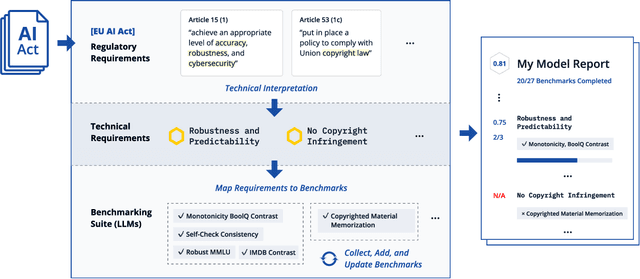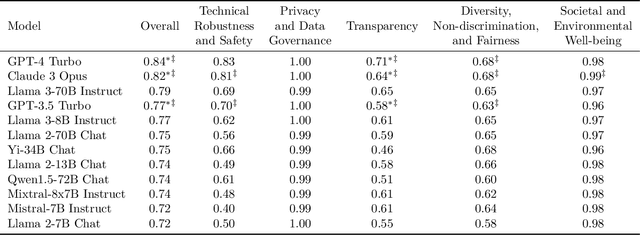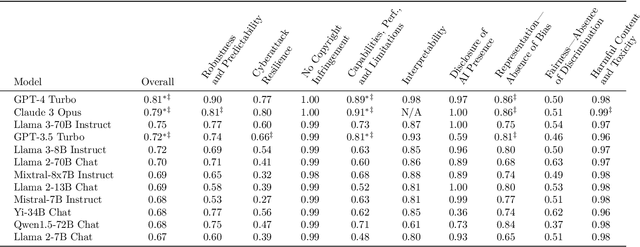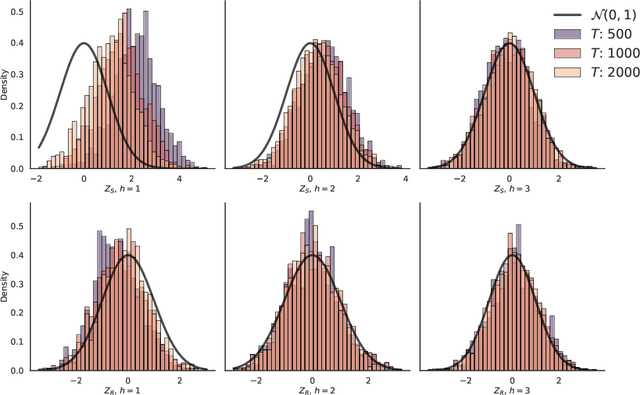Robin Staab
Fewer Weights, More Problems: A Practical Attack on LLM Pruning
Oct 09, 2025Abstract:Model pruning, i.e., removing a subset of model weights, has become a prominent approach to reducing the memory footprint of large language models (LLMs) during inference. Notably, popular inference engines, such as vLLM, enable users to conveniently prune downloaded models before they are deployed. While the utility and efficiency of pruning methods have improved significantly, the security implications of pruning remain underexplored. In this work, for the first time, we show that modern LLM pruning methods can be maliciously exploited. In particular, an adversary can construct a model that appears benign yet, once pruned, exhibits malicious behaviors. Our method is based on the idea that the adversary can compute a proxy metric that estimates how likely each parameter is to be pruned. With this information, the adversary can first inject a malicious behavior into those parameters that are unlikely to be pruned. Then, they can repair the model by using parameters that are likely to be pruned, effectively canceling out the injected behavior in the unpruned model. We demonstrate the severity of our attack through extensive evaluation on five models; after any of the pruning in vLLM are applied (Magnitude, Wanda, and SparseGPT), it consistently exhibits strong malicious behaviors in a diverse set of attack scenarios (success rates of up to $95.7\%$ for jailbreak, $98.7\%$ for benign instruction refusal, and $99.5\%$ for targeted content injection). Our results reveal a critical deployment-time security gap and underscore the urgent need for stronger security awareness in model compression.
Mind the Gap: A Practical Attack on GGUF Quantization
May 24, 2025Abstract:With the increasing size of frontier LLMs, post-training quantization has become the standard for memory-efficient deployment. Recent work has shown that basic rounding-based quantization schemes pose security risks, as they can be exploited to inject malicious behaviors into quantized models that remain hidden in full precision. However, existing attacks cannot be applied to more complex quantization methods, such as the GGUF family used in the popular ollama and llama.cpp frameworks. In this work, we address this gap by introducing the first attack on GGUF. Our key insight is that the quantization error -- the difference between the full-precision weights and their (de-)quantized version -- provides sufficient flexibility to construct malicious quantized models that appear benign in full precision. Leveraging this, we develop an attack that trains the target malicious LLM while constraining its weights based on quantization errors. We demonstrate the effectiveness of our attack on three popular LLMs across nine GGUF quantization data types on three diverse attack scenarios: insecure code generation ($\Delta$=$88.7\%$), targeted content injection ($\Delta$=$85.0\%$), and benign instruction refusal ($\Delta$=$30.1\%$). Our attack highlights that (1) the most widely used post-training quantization method is susceptible to adversarial interferences, and (2) the complexity of quantization schemes alone is insufficient as a defense.
Finetuning-Activated Backdoors in LLMs
May 22, 2025Abstract:Finetuning openly accessible Large Language Models (LLMs) has become standard practice for achieving task-specific performance improvements. Until now, finetuning has been regarded as a controlled and secure process in which training on benign datasets led to predictable behaviors. In this paper, we demonstrate for the first time that an adversary can create poisoned LLMs that initially appear benign but exhibit malicious behaviors once finetuned by downstream users. To this end, our proposed attack, FAB (Finetuning-Activated Backdoor), poisons an LLM via meta-learning techniques to simulate downstream finetuning, explicitly optimizing for the emergence of malicious behaviors in the finetuned models. At the same time, the poisoned LLM is regularized to retain general capabilities and to exhibit no malicious behaviors prior to finetuning. As a result, when users finetune the seemingly benign model on their own datasets, they unknowingly trigger its hidden backdoor behavior. We demonstrate the effectiveness of FAB across multiple LLMs and three target behaviors: unsolicited advertising, refusal, and jailbreakability. Additionally, we show that FAB-backdoors are robust to various finetuning choices made by the user (e.g., dataset, number of steps, scheduler). Our findings challenge prevailing assumptions about the security of finetuning, revealing yet another critical attack vector exploiting the complexities of LLMs.
MixAT: Combining Continuous and Discrete Adversarial Training for LLMs
May 22, 2025Abstract:Despite recent efforts in Large Language Models (LLMs) safety and alignment, current adversarial attacks on frontier LLMs are still able to force harmful generations consistently. Although adversarial training has been widely studied and shown to significantly improve the robustness of traditional machine learning models, its strengths and weaknesses in the context of LLMs are less understood. Specifically, while existing discrete adversarial attacks are effective at producing harmful content, training LLMs with concrete adversarial prompts is often computationally expensive, leading to reliance on continuous relaxations. As these relaxations do not correspond to discrete input tokens, such latent training methods often leave models vulnerable to a diverse set of discrete attacks. In this work, we aim to bridge this gap by introducing MixAT, a novel method that combines stronger discrete and faster continuous attacks during training. We rigorously evaluate MixAT across a wide spectrum of state-of-the-art attacks, proposing the At Least One Attack Success Rate (ALO-ASR) metric to capture the worst-case vulnerability of models. We show MixAT achieves substantially better robustness (ALO-ASR < 20%) compared to prior defenses (ALO-ASR > 50%), while maintaining a runtime comparable to methods based on continuous relaxations. We further analyze MixAT in realistic deployment settings, exploring how chat templates, quantization, low-rank adapters, and temperature affect both adversarial training and evaluation, revealing additional blind spots in current methodologies. Our results demonstrate that MixAT's discrete-continuous defense offers a principled and superior robustness-accuracy tradeoff with minimal computational overhead, highlighting its promise for building safer LLMs. We provide our code and models at https://github.com/insait-institute/MixAT.
Robust LLM Fingerprinting via Domain-Specific Watermarks
May 22, 2025Abstract:As open-source language models (OSMs) grow more capable and are widely shared and finetuned, ensuring model provenance, i.e., identifying the origin of a given model instance, has become an increasingly important issue. At the same time, existing backdoor-based model fingerprinting techniques often fall short of achieving key requirements of real-world model ownership detection. In this work, we build on the observation that while current open-source model watermarks fail to achieve reliable content traceability, they can be effectively adapted to address the challenge of model provenance. To this end, we introduce the concept of domain-specific watermarking for model fingerprinting. Rather than watermarking all generated content, we train the model to embed watermarks only within specified subdomains (e.g., particular languages or topics). This targeted approach ensures detection reliability, while improving watermark durability and quality under a range of real-world deployment settings. Our evaluations show that domain-specific watermarking enables model fingerprinting with strong statistical guarantees, controllable false positive rates, high detection power, and preserved generation quality. Moreover, we find that our fingerprints are inherently stealthy and naturally robust to real-world variability across deployment scenarios.
COMPL-AI Framework: A Technical Interpretation and LLM Benchmarking Suite for the EU Artificial Intelligence Act
Oct 10, 2024



Abstract:The EU's Artificial Intelligence Act (AI Act) is a significant step towards responsible AI development, but lacks clear technical interpretation, making it difficult to assess models' compliance. This work presents COMPL-AI, a comprehensive framework consisting of (i) the first technical interpretation of the EU AI Act, translating its broad regulatory requirements into measurable technical requirements, with the focus on large language models (LLMs), and (ii) an open-source Act-centered benchmarking suite, based on thorough surveying and implementation of state-of-the-art LLM benchmarks. By evaluating 12 prominent LLMs in the context of COMPL-AI, we reveal shortcomings in existing models and benchmarks, particularly in areas like robustness, safety, diversity, and fairness. This work highlights the need for a shift in focus towards these aspects, encouraging balanced development of LLMs and more comprehensive regulation-aligned benchmarks. Simultaneously, COMPL-AI for the first time demonstrates the possibilities and difficulties of bringing the Act's obligations to a more concrete, technical level. As such, our work can serve as a useful first step towards having actionable recommendations for model providers, and contributes to ongoing efforts of the EU to enable application of the Act, such as the drafting of the GPAI Code of Practice.
Ward: Provable RAG Dataset Inference via LLM Watermarks
Oct 04, 2024Abstract:Retrieval-Augmented Generation (RAG) improves LLMs by enabling them to incorporate external data during generation. This raises concerns for data owners regarding unauthorized use of their content in RAG systems. Despite its importance, the challenge of detecting such unauthorized usage remains underexplored, with existing datasets and methodologies from adjacent fields being ill-suited for its study. In this work, we take several steps to bridge this gap. First, we formalize this problem as (black-box) RAG Dataset Inference (RAG-DI). To facilitate research on this challenge, we further introduce a novel dataset specifically designed for benchmarking RAG-DI methods under realistic conditions, and propose a set of baseline approaches. Building on this foundation, we introduce Ward, a RAG-DI method based on LLM watermarks that enables data owners to obtain rigorous statistical guarantees regarding the usage of their dataset in a RAG system. In our experimental evaluation, we show that Ward consistently outperforms all baselines across many challenging settings, achieving higher accuracy, superior query efficiency and robustness. Our work provides a foundation for future studies of RAG-DI and highlights LLM watermarks as a promising approach to this problem.
Discovering Clues of Spoofed LM Watermarks
Oct 03, 2024



Abstract:LLM watermarks stand out as a promising way to attribute ownership of LLM-generated text. One threat to watermark credibility comes from spoofing attacks, where an unauthorized third party forges the watermark, enabling it to falsely attribute arbitrary texts to a particular LLM. While recent works have demonstrated that state-of-the-art schemes are in fact vulnerable to spoofing, they lack deeper qualitative analysis of the texts produced by spoofing methods. In this work, we for the first time reveal that there are observable differences between genuine and spoofed watermark texts. Namely, we show that regardless of their underlying approach, all current spoofing methods consistently leave observable artifacts in spoofed texts, indicative of watermark forgery. We build upon these findings to propose rigorous statistical tests that reliably reveal the presence of such artifacts, effectively discovering that a watermark was spoofed. Our experimental evaluation shows high test power across all current spoofing methods, providing insights into their fundamental limitations, and suggesting a way to mitigate this threat.
A Synthetic Dataset for Personal Attribute Inference
Jun 11, 2024Abstract:Recently, powerful Large Language Models (LLMs) have become easily accessible to hundreds of millions of users worldwide. However, their strong capabilities and vast world knowledge do not come without associated privacy risks. In this work, we focus on the emerging privacy threat LLMs pose - the ability to accurately infer personal information from online texts. Despite the growing importance of LLM-based author profiling, research in this area has been hampered by a lack of suitable public datasets, largely due to ethical and privacy concerns associated with real personal data. In this work, we take two steps to address this problem: (i) we construct a simulation framework for the popular social media platform Reddit using LLM agents seeded with synthetic personal profiles; (ii) using this framework, we generate SynthPAI, a diverse synthetic dataset of over 7800 comments manually labeled for personal attributes. We validate our dataset with a human study showing that humans barely outperform random guessing on the task of distinguishing our synthetic comments from real ones. Further, we verify that our dataset enables meaningful personal attribute inference research by showing across 18 state-of-the-art LLMs that our synthetic comments allow us to draw the same conclusions as real-world data. Together, this indicates that our dataset and pipeline provide a strong and privacy-preserving basis for future research toward understanding and mitigating the inference-based privacy threats LLMs pose.
Exploiting LLM Quantization
May 28, 2024Abstract:Quantization leverages lower-precision weights to reduce the memory usage of large language models (LLMs) and is a key technique for enabling their deployment on commodity hardware. While LLM quantization's impact on utility has been extensively explored, this work for the first time studies its adverse effects from a security perspective. We reveal that widely used quantization methods can be exploited to produce a harmful quantized LLM, even though the full-precision counterpart appears benign, potentially tricking users into deploying the malicious quantized model. We demonstrate this threat using a three-staged attack framework: (i) first, we obtain a malicious LLM through fine-tuning on an adversarial task; (ii) next, we quantize the malicious model and calculate constraints that characterize all full-precision models that map to the same quantized model; (iii) finally, using projected gradient descent, we tune out the poisoned behavior from the full-precision model while ensuring that its weights satisfy the constraints computed in step (ii). This procedure results in an LLM that exhibits benign behavior in full precision but when quantized, it follows the adversarial behavior injected in step (i). We experimentally demonstrate the feasibility and severity of such an attack across three diverse scenarios: vulnerable code generation, content injection, and over-refusal attack. In practice, the adversary could host the resulting full-precision model on an LLM community hub such as Hugging Face, exposing millions of users to the threat of deploying its malicious quantized version on their devices.
 Add to Chrome
Add to Chrome Add to Firefox
Add to Firefox Add to Edge
Add to Edge